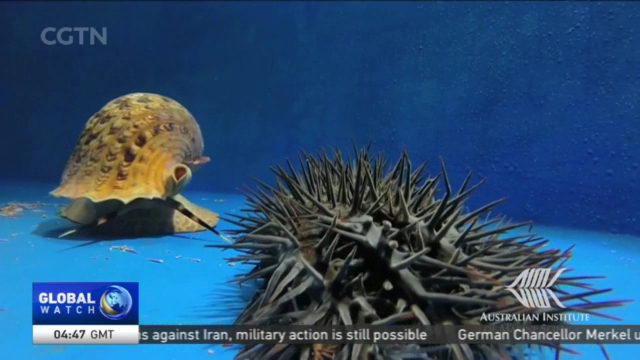
13:35, 23-Jun-2019
Saving Great Barrier Reef: Scientists trying to deter deadly starfish from feeding on corals
Updated
17:14, 09-Jul-2019

Scientists say Australia's Great Barrier Reef is under threat from a highly efficient predator. The Crown of Thorns Starfish feeds on corals at an alarming rate. Researchers in Queensland believe the answer to deterring the deadly starfish may already exist on the reef. Greg Navarro explains.
In a nondescript room in a remote Queensland research facility - a series of tanks containing slow moving, alien-like, seemingly harmless creatures. But scientists say the Crown of Thorns Starfish possesses a voracious appetite for the Great Barrier Reef.
SVEN UTHICKE, PRINCIPAL RESEARCH SCIENTIST AUSTRALIAN INSTITUTE OF MARINE SCIENCE "On an individual reef basis they can eat the whole reef basically very quickly with in a couple of years if you have a big outbreak - you have thousands of specimens, thousands of individuals and they can practically eat the whole reef."
These baby Crown of Thorn Starfish will devour this section of coral in just a couple of days. And scientists estimate that there are hundreds of thousands feeding on the Great Barrier Reef, which is already struggling to rebound from cyclones and bleaching events.
CHERIE MOTTI, MARINE CHEMIST AUSTRALIAN INSTITUTE OF MARINE SCIENCE "Mostly corals can recover from those particular threats. The Crown of Thorns Starfish on the other hand represent a real threat because once the infestation occurs they will strip off all of the coral tissue and the corals can't recover."
GREG NAVARRO TOWNSVILLE "One of the problems that scientists face in trying to contain the Crown of Thorns Starfish is that they are prolific breeders. In fact, one female can lay about 60 million eggs in a matter of months."
And this species of starfish doesn't have many predators.
THOMAS ARMSTRONG, TECHNICIAN AUSTRALIAN INSTITUTE OF MARINE SCIENCE "The Crown of Thorns Starfish has a lot of defence mechanisms with their spikes and their toxins that are released that dissuade fish from going after them."
The answer may also be in this facility - the Giant Triton snail. It's one of the few known predators and apparently, the Crown of Thorns know it.
CHERIE MOTTI, MARINE CHEMIST AUSTRALIAN INSTITUTE OF MARINE SCIENCE "We have done some studies here at AIMS where we have put the water surrounding the giant triton snail into a tank with the crown of thorns starfish and what we see is the starfish literally flips out of the tank, it tries to escape, it will actually turn upside down and run around on the surface of the water so what we know is it is sensing some sort of chemistry from its predator and it knows that it is in danger and to tries to flee."
That's why researchers at the Australian Institute for Marine Biology are working to develop a kind of chemical deterrent aimed at keeping Crown of Thorns Starfish away from the reef. They're also working on a system to detect outbreaks before they happen. There's a sense of immediacy to their work.
THOMAS ARMSTRONG, TECHNICIAN AUSTRALIAN INSTITUTE OF MARINE SCIENCE "The faster we can get these things figured out the better."
Because considering the health of the Great Barrier Reef, the one thing they say they don't have much of is time. Greg Navarro, CGTN, Townsville.
SITEMAP
Copyright © 2018 CGTN. Beijing ICP prepared NO.16065310-3
Copyright © 2018 CGTN. Beijing ICP prepared NO.16065310-3